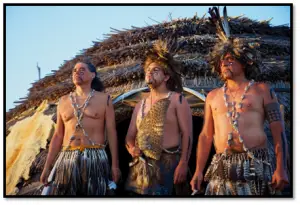Little has been known about the small group called the Chumash. They are one of the first tribes that inhabited the historic lands of the United States. The Chumash Tribe were Historic Native American people who formerly resided at the central and southern coastal regions of what is now California, extending their territory from the Morro Bay in the north to Malibu in the south.
History of Chumash Tribe Life
They also occupied three of the nearby Islands: Santa Cruz, Santa Rosa, and San Miguel. Archaeologists who have made researches on the remains of the Chumash Tribe people have claimed that they have deep roots in the Santa Barbara Channel area and lived along the southern California coast for millennia.
Today, modern places with Chumash origins include the Cayucos, Malibu, Lompoc, Ojai, Pismo Beach, Port Hueneme, Point Mugu, Lake Castaic, Piru, Saticoy, Simi Valley and Somis.
Culture
The Chumash people, like every other tribe of the past, were hunter-gatherers and were very adept at fishing during the Spanish colonization. They are among the very few that have the uncanny ability to navigate the ocean.
Languages
The Chumash used distinct selections of languages that are only understood by them alone. Several related languages under the name “Chumash” were spoken. However, these languages were well recorded and documented in the unpublished field notes of linguist John Peabody Harrington. Some well-documented Chumash dialects are the Barbareño, Ventureño, and the Ineseño. These dialects are pretty related since they all have seemingly the same recorded patterns and terms.

Industries
The Chumash had also mastered the arts of weaving, beading, and herbal medicine.
Basketry
Anthropologists in their search for more Chumash artifacts have collected some Chumash baskets. While that isn’t much of an artifact to find, it’s also good to know that Chumash basketry was, in fact, a work of art.
Two of the finest collections are at the Smithsonian Institution in Washington D.C., and at the Musée de Homme (Museum of Mankind) in Paris.
While they have the finest one, the Santa Barbara Museum of Natural History is the one having the largest collection of Chumash baskets.
Bead-making and trading
The Chumash of the Northern Islands were the center of a regional trade network before. They have learned to produce beads and used them as currency for trading to nearby Chumash settlements, or other tribes as well. These specific beads were made from Olivella shells.
These shell beads were traded to neighboring groups and have been discovered all over Alta California. Over the course of history, millions of shell beads were manufactured and traded on the Santa Cruz Island. It has been opinionated that exclusive control over stone quarries used to manufacture the materials needed for the production of beads that could have played a role in the development of the Chumash society.
There is more to know about these interesting Chumash people. Their culture has influenced a significant portion of the United States today, which is just one of the reasons why extensive research and familiarization of these people are needed.
chumash tribe food, Chumash homes, Chumash life, Chumash natural resources, Chumash tools, Chumash location, Chumash beliefs, Chumash traditions
